Nov 19, 2015
Terrorism and a cold winter refugee crisis
Not only did President Obama assert the morning of the latest Paris massacre that “ISIS is contained.” Along with Democrat presidential candidate Bernie Sanders and other global warming alarmists, he continues to insist that climate change is the gravest threat facing mankind, nature and our planet. This article underscores how false those assertions are.
Fossil fuels actually contribute very little to climate change, which is driven by powerful natural forces over which we have no control. Cold weather kills twenty times more people than hot weather. And Middle Eastern refugees streaming into Europe could face bone-rattling, lethal cold weather, if another Siberian Express roars in from the Arctic. THAT is what Paris climate conferees should address - not how to abolish hydrocarbon use, further hogtie economies, keep 1.3 billion people forever impoverished, and redistribute the world’s wealth.
Thank you for posting our article, quoting from it, and forwarding it to your friends and colleagues. Please credit Joe D’Aleo, Allan MacRae and Madhav Khandekar for their contributions to it.
Best regards,
Paul
Terrorism and a cold winter refugee crisis
A brutal cold spell could kill refugees. Paris COP21 delegates need to discuss this climate issue.
Paul Driessen, Joe D’Aleo, Allan MacRae and Madhav Khandekar
Even after the latest Paris massacres - and previous radical Islamist atrocities in the USA, France, Britain, Canada, Spain, India, Iraq, Syria, Nigeria and elsewhere - politicians absurdly say hypothetical manmade global warming is the greatest threat facing humanity. In reality, fossil fuel contributions to climate change pose few dangers to people or planet, and winters kill 20 times more people than hot weather.
After being assured snowy winters would soon be something only read about in history books, Europe was shaken by five brutally cold winters this past decade. Thousands died, because they were homeless, lived in drafty homes with poor heating systems, or could not afford adequate fuel.
It could happen again, with even worse consequences. “Millions of desperate people are on the march,” Walter Russell Mead recently wrote in the Wall Street Journal. “Sunni refugees driven out by the barbarity of the Assad regime in Syria, Christians and Yazidis fleeing the pornographic violence of Islamic State, millions more of all faiths and no faith fleeing poverty and oppression without end.”
Where are they heading? Mostly not into neighboring Arab countries, most of which have yanked their welcome mats. Instead, if they’re not staying in Turkey, they’re going north to Europe - into the path the extremely cold “Siberian Express” has increasingly taken. Germany alone could face the challenge of feeding and sheltering 800,000 to 1,000,000 freezing refugees this winter.
If a blast of frigid Siberian air should hit, temperatures in parts of eastern and northern Europe and the western Former Soviet Union could become 70 degrees F (39C) colder than cold spells in much of the Middle East. During the coldest Siberian outbreaks, it gets as lethally cold as -40F (-40C).
Northern and eastern Europeans are largely acclimated to such cold. However, for refugees from regions where winters average 20 to 30 degrees warmer, makeshift houses or tents will make their sojourn a bone-chilling experience. Europe’s exorbitant energy costs, resulting from its obeisance to climate chaos credos, could make this an even worse humanitarian crisis.
However, to listen to the UN, many world leaders, environmental NGOs, scientists from the climate alarm industry, and their sycophant media - especially on the eve of their Paris 2015 global warming summit - threats from cold weather are not supposed to happen. Just 15 years ago, the German paper Spiegel proclaimed, “Good-bye winter: In Germany bitter cold winters are now a thing of the past.” That same year, a British Climate Research Unit scientist said “children aren’t going to know what snow is.”
The media dutifully repeated similar claims each year, until unbelievably cold, snowy winters began hitting in 2008/09. In December 2010, England had its second-coldest December since 1659, amid the Little Ice Age. For five years, 2008-2013, snow paralyzed travel in England and northern and western Europe. Not surprisingly, the same media then blamed manmade global warming for the harsh winters.
In reality, natural Atlantic Ocean cycles lasting around 60 years control winter temperatures in Europe and Eastern North America. When the North Atlantic warms, “blocking high pressure systems” largely prevent warm Atlantic air from reaching Europe.
There is also a strong correlation between the sun’s geomagnetic activity and these blocking-induced cold winters in Europe. The five brutally cold winters ending in 2012/13 had the lowest level of solar geomagnetic activity in the entire record, dating back some 90 years.
When the North Atlantic is warm and the sun’s geomagnetic patterns are weak, these blocking patterns keep warmer Atlantic air out of Europe. Frigid air from off deep snows in Siberia can then more easily invade from the east, bringing sub-zero cold and heavy snows. That’s what happened from 2008 to 2013.
The ocean and solar factors eased in 2013, and the last two years have seen more Atlantic air and milder winters. However both solar and ocean patterns are starting to return to the situation where cold invasions are more likely. That could usher in nasty surprises for the Middle Eastern refugees.
Even this year’s early winter October cold brought news stories about Syrian children becoming sick amid exposure to colder weather than they were used to. In Austria, adults and children alike were already complaining about the weather and wishing they could go home.
In fact, cold weather kills 20 times more people than hot weather, according to a Lancet medical journal study that analyzed 74 million deaths in 384 locations across 13 countries. It should be required reading for the 40,000-plus bureaucrats, politicians, activists and promoters who will soon descend on Paris, to enjoy five-star hotels and restaurants while blathering endlessly about dire threats of global warming.
They should ponder the fact that the Lancet study reflects normal societies in peaceful countries. Even there, many more people die each year during the four winter months than in the eight non-winter months. Indeed, there even the United States experiences some 100,000 Excess Winter Deaths per year.
In the United Kingdom, the winter death rate is about twice as high as in the USA: excess winter deaths range up to 50,000 per year - due to the UK’s poorer home insulation and heating systems, and much higher energy costs caused by its climate and renewable energy policies.
The refugees’ excess winter death toll could well be even greater, due to the high cost of European energy and the migrants’ extreme poverty, poor nutrition, inadequate clothing and blankets, preexisting diseases, and makeshift housing: tents, trailers and other dwellings that have little or no insulation or central heat.
Systematic misinformation about the dangers of fossil fuels and hot versus cold weather has helped make this crisis much worse than needs be. Climate alarmists will thus bear the blame for thousands of avoidable deaths among refugees this winter, especially if the Siberian Express invades once again.
The Paris climate conferees need to focus on humanity’s real and immediate dangers: this rapidly growing refugee crisis, abysmal EU economies and job losses and the billions worldwide who still lack the adequate, reliable, affordable energy required to end their crushing poverty, malnutrition, disease and early death, by ensuring clean water, proper sanitation, modern hospitals, lights, refrigerators and plentiful food. The climate conferees must address the following much more pressing questions.
How is climate change more important than safeguarding refugees who are already suffering from cold weather? Should conferees be focused on hypothetical future manmade climate chaos, while EU nations squabble over who will take how many refugees and potential terrorists, amid a possible winter crisis? What contingency plans do they have for another bout of frigid weather possibly invading the continent?
When a million refugees are freezing in squalid conditions with inadequate shelter, food, heat, clothing and medical care, and 1.3 billion people still do not have electricity - why would the world commit to spending billions on alleged future global warming catastrophes? As Bjorn Lomborg puts it, why would the world also want to give up nearly $1 trillion in GDP every year for the rest of this century, to avert a total hypothetical (computer modeled) temperature rise of just 0.306 degrees C (0.558 F) by 2100?
Where will the money come from to combat growing war and terrorism, aid the millions displaced by these horrors, rebuild devastated cities, put millions of people back to work, and bring electricity and better lives to billions of others - if we continue this obsession over global warming? Do humans really play a big enough roll in climate change to justify these incomprehensible price tags? Where is the actual evidence? Not computer models or press releases - the actual evidence?
It would be an unconscionable crime against humanity, if the nations gathering in Paris implement policies to protect our planet’s energy-deprived masses from hypothetical manmade climate disasters decades from now, by perpetuating poverty and disease that kill millions more people tomorrow.
These are the real reasons climate change is a critical moral issue. We need to we recognize that, and stop playing games with people’s lives. We must acknowledge that horrific computer model scenarios do not reflect planetary reality - and must not guide energy policy.
Joe D’Aleo is a Certified Consulting Meteorologist and American Meteorological Society Fellow and co-founder of The Weather Channel. Paul Driessen is senior policy analyst for the Committee For A Constructive Tomorrow. Climate experts Allan MacRae and Madhav Khandekar contributed to this article.
Jul 14, 2015
Despite the ‘urgency’ of Paris climate talks, a U.N. global poll rates climate change dead last
Roy Spencer
UAH and RSSS July Updates show temperatures not spiking yet due to El Nino and no statistically significant warming for 20 years.
Dr. Roy Spencer
NOTE: This is the fourth monthly update with our new Version 6.0 dataset. Differences versus the old Version 5.6 dataset are discussed here.
The Version 6.0 global average lower tropospheric temperature (LT) anomaly for July, 2015 is +0.18 deg. C, down considerably from the June, 2015 value of +0.33 deg. C (click for full size version):
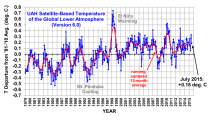
ICECAP NOTE:
The global, hemispheric, and tropical LT anomalies from the 30-year (1981-2010) average for the last 20 Julys in ranking order shows it was the 9th warmest. NOAA’s intentionally corrupted data showed the global temperatures are the warmest ever for any month.
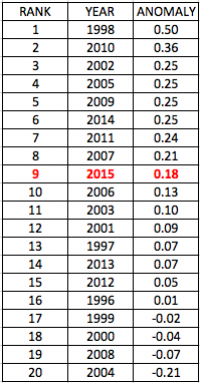
Strong July cooling occurred in the Southern Hemisphere extratropics, with a weak drop in the Northern Hemisphere extratropics. The tropics continue to warm with El Nino conditions there.
The global image for July, 2015 is now available here.

Enlarged

Enlarged
Also see the composite of the global monthly data that goes into the operational dynamical models for short to medium and longer range. This is before NCDC adds the adjustments to get the results demanded for selling the global warming scam to the continue the indoctrination of the ignorati and provide the substitute communion for the members of in the church of climate scientology we see haunting the MSM and internet evangelizing on the message of man made climate change. It shows just an anomaly globally of +0.15C for the 1981-2010 base period falling in the middle of the pack the last decade. As predicted, NOAA and NASA barbecued their July temperatures? AMS continues to publish NOAA’s corrupt State of the Climate Report, which many meteorologists say goes right in the trash can when the mailman delivers it.
_thumb.png)
Enlarged
---------
Despite the ‘urgency; of Paris climate talks, a U.N. global poll rates climate change dead last
By Anthony Watts and Ryan Maue
Update: Climate Scientists Rip Apart EPA’s Global Warming Rule “Well the one thing you don’t hear President [Barack] Obama mention is how much his proposed emissions reductions will reduce global warming,” wrote Dr. Judith Curry, a climatologist at Georgia Tech. “It has been estimated that the U.S. [climate plan] of 28% emissions reduction by 2025 will prevent 0.03 [degrees Celsius] in warming by 2100.” “And these estimates assume that climate model projections are correct,” Curry wrote, “if the climate models are over-sensitive to CO2, the amount of warming prevented will be even smaller.”
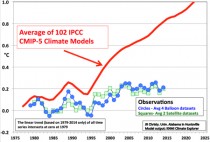
Despite the ‘urgency’ of Paris climate talks, a U.N. sponsored global poll rates climate change dead last
From the United Nations “MY World” initiative, which has recorded the opinions for All Countries & Country Groups with votes of 7,679,273 at the time of this writing. They describe it as:
MY World is a United Nations global survey for citizens. Working with partners, we aim to capture people’s voices, priorities and views, so world leaders can be informed as they begin the process of defining the next set of global goals to end poverty.
The data collected so far is telling, at least about opinions surrounding global warming aka climate change. It is dead last in the list of concerns queried:
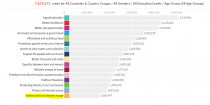
un-poll-agw-dead-last
This next graph is even more interesting:
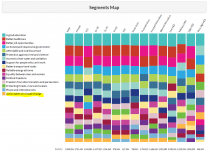
un-poll-agw-dead-last-segments
It too shows “action taken on climate change” as dead last among all age groups, gender, and education, but there are three curious columns on the right where it doesn’t come in last, but comes in low. These are the countries where people live that have medium to very high “HDI” which stands for Human Development Index.
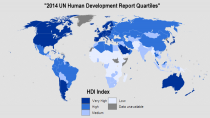
global-hdi-map
Note that in these countries (medium to dark blue), people already have the things in place that come in lower than the climate change, so they tend to take them for granted. Countries that have a high HDI have reliable energy, Internet access, political freedoms, and social programs, so it is no wonder these sorts of things come in as lower concerns in medium to high HDI countries. These countries also tend to have a population that has people economically free enough to worry about things like climate change, whereas in some countries, you can’t get electricity or get on the Internet to read the latest doom and gloom being spewed by MSM outlets like the Guardian.
--------------
Winter is coming: Earth awaits ‘mini ice age’ in 15 years, solar cycle study suggests
Earth is facing the prospect of a ‘mini ice age’ this century, with our sun’s activity projected to fall 60 percent in the 2030s, British astrophysicists say, based on the results of new research that they claim allows exact predictions of solar cycles.
Our planet is just 15 years from a new ‘mini ice age’ that could cause extremely cold winters characterized by the freezing of normally ice-free rivers as well as by year-round snow fields in areas that have never witnessed such climate conditions before, a group of astrophysicists claim.
The scientists could draw such a conclusion based on a new model of the sun’s activity that reportedly enables the researchers to make “extremely accurate predictions” of changes in solar activity.
Although, the fact that the sun’s activity varies within a 10-12 year long cycles was first discovered almost two centuries ago, in 1843, all the previously existing explanatory models failed to fully explain the fluctuations with each cycle as well as between the cycles.
Until now, the astrophysicists thought that the variations of the solar activity depended on the dynamo caused by convecting fluid deep inside the sun.
The latest study conducted by a research team from Northumbria University, Newcastle upon Tyne, UK, and led by Professor Valentina Zharkova demonstrated that the variations in the Sun’s activity are caused by two dynamo processes - one deep in the convection zone of the sun and one near its surface.
The research team analyzed three solar activity cycles that cover the period from 1976 to 2008 studying magnetic field activity of the sun during this time by using a technique called principal component analysis of the magnetic field observations from the Wilcox Solar Observatory in California.
The scientists discovered magnetic waves in two different layers of the Solar interior that “fluctuate between the northern and southern hemispheres of the Sun.”
“We found magnetic wave components appearing in pairs, originating in two different layers in the Sun’s interior. They both have a frequency of approximately 11 years, although this frequency is slightly different, and they are offset in time,” said Professor Zharkova.
Later, they also compared their findings concerning the intensity of the Sun’s activity with each year’s data on the average number of sunspots - a strong indicator of solar activity.
As a result, the team managed to create a very accurate model of predicting the solar activity fluctuations.
“Combining both waves together and comparing to real data for the current solar cycle, we found that our predictions showed an accuracy of 97 percent,” said Zharkova.
The study findings were presented at the National Astronomy Meeting in Llandudno on July 9 and published in the Royal Astronomical Society papers.
The model demonstrates that solar activity will fall by 60 percent by 2030 as the magnetic waves inside the Sun will become increasingly more desynchronized during the next two cycles, especially during cycle 26, which covers the decade between 2030 and 2040.
“In cycle 26, the two waves exactly mirror each other - peaking at the same time but in opposite hemispheres of the Sun. Their interaction will be disruptive, or they will nearly cancel each other,” Professor Zharkova said.
“Effectively, when the waves are approximately in phase, they can show strong interaction, or resonance, and we have strong solar activity. When they are out of phase, we have solar minimums. When there is full phase separation, we have the conditions last seen during the Maunder minimum, 370 years ago,” she added.
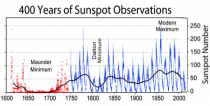
The Maunder minimum is a name of a period between 1645 and 1715 characterized by prolonged low solar activity as well as by extremely cold winters in Europe and North America as it also correlates with a climatic period between 1550 and 1850 called the ‘Little Ice Age.’
Jul 06, 2015
With Pollution Levels Dropping, is Small Particle Air Pollution Really Killing Americans?
By Steve Goreham
Originally published in Communities Digital News.

Unnoticed by most citizens, last week the United States Senate introduced the “Secret Science Reform Act of 2015.” The act is aimed at the Environmental Protection Agency’s practice of refusing to disclose data from scientific studies that support new pollution regulations. The act indirectly questions the EPA assertion that Americans are dying today from small particle air pollution.
Past EPA Administrator Lisa Jackson testified before Congress in 2011, stating, “Particulate matter causes premature death. It doesn’t make you sick. It’s directly causal to dying sooner than you should.” Particulate matter refers to PM2.5, classified by the EPA as particles smaller than 2.5 microns in diameter, much smaller than the eye can see. Particle pollution is a mixture of dust, nitrates and sulfates, metals, pollen, and organic chemicals.
The EPA claims that any level of small particles can cause premature death. The agency warns that death may be short-term, occurring within a few hours of inhalation, or may be caused by long-term inhalation of PM2.5 over several years. EPA policy advisor Amanda Brown asserted that between 130,000 and 320,000 Americans died prematurely in 2005 due to small particle pollution, an incredible 6 to 15 percent of total US deaths.
EPA claims that particle pollution triggers heart failure, respiratory failure, or other causes of death. For example, suppose a senior citizen dies a few days before his 67th birth day and a coroner determines heart failure to be the cause of death. According to the EPA, the death may have been “premature” and caused by small particle air pollution.
The EPA uses “prevention” of premature deaths from small particles to justify tighter pollution regulations. The EPA’s proposed Clean Power Plan, which will force closure of coal-fired power plants across the nation, is an example. The EPA claims that implementation of the CPP will prevent up to 6,600 premature deaths and $93 billion in climate and public health benefits. But the monetized climate benefits are essentially zero. Almost all of the $93 billion comes from an EPA calculation on savings from avoidance of premature death from small particles.
_thumb.jpg)
Enlarged
Today, our nation’s air is remarkably clean, especially when compared to 50 years ago. Incidents of serious air pollution are rare. According to the EPA, the concentration of six major air pollutants, lead, nitrous oxides, sulfur dioxide, ozone, and particulates, are down more than a combined 70 percent since 1980. PM2.5 particle pollution is typically below the EPA national standard of 15 micrograms per cubic meter of air.
Fifteen micrograms per cubic meter is not very much. Dr. James Enstrom, retired researcher from the UCLA School of Public Health, points out that a person breathing in 15 micrograms of small particles per cubic meter would inhale only about one teaspoon of these microscopic particles over an 80-year lifespan. The EPA’s assertion that this small amount of particles causes premature death is not credible.
How does the EPA conclude that thousands of Americans die each year from particle pollution? No coroner ever attributes a cause of death to particle pollution. Instead, the EPA relies on epidemiological observational studies that associate particle pollution with death.
Epidemiological studies analyze statistical associations between exposure to an agent and appearance of disease in a population. An example is the Doll and Hill study in the 1950s that found that cigarette smoking caused lung cancer in a population of 41,000 British medical doctors. EPA has concluded that associations found in epidemiological studies show that inhalation of small particles cause premature death.
But the association between death and particle pollution found by studies that EPA relies on is shaky at best. Relative risk (RR) is the ratio of incidence of disease in an exposed population to a control population. The size of the relative risk is a measure of the chance that an association is causal.
The Harvard Six Cities study of 1993 and the American Cancer Society study of 1995, two studies that form the basis of EPA small particle science, found an increase in relative risk of less than 20 percent (RR=1.2). An increase in death rates of less than 20 percent (RR=1.2) is almost statistically indistinguishable from zero. In contrast, the Doll and Hill study on cigarettes and lung cancer found smokers had 10 times the rate of lung cancer and non-smokers, a relative risk of RR=10. The weak association (small relative risk) between death and particle pollution that the EPA judges to be causal could be due to other factors in the measured populations or even random chance.
But what stinks to high heaven is that data from the Harvard Six Cities and American Cancer Society studies have never been released. Other scientists are not able to replicate and verify the results of these studies. In effect, the EPA is asking all to “trust us” on the science of death from particle pollution. The Secret Science Reform Act proposes to force the EPA to disclose data from studies that support the need for EPA regulations.
Further, EPA is often the funding agency for epidemiological studies that are then used to justify new air pollution regulations. EPA supports such studies either directly or indirectly through grants to organizations such as the American Lung Association and the American Cancer Society. For example, over the last decade the EPA has provided more than $20 million in grants to the American Lung Association, a group that supports EPA efforts for more stringent air pollution regulations (payback was the ads they ran unsupported by the data).
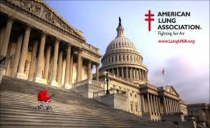
The result is a massive, costly, and growing burden on American citizens in the name of clean air. NERA Economic Consulting estimates that the Clean Power Plan will cost US citizens some $400 billion in compliance costs over the next 15 years. But the savings from “prevention of premature deaths” from particle pollution are likely imaginary.
Steve Goreham is Executive Director of the Climate Science Coalition of America and author of the book The Mad, Mad, Mad World of Climatism: Mankind and Climate Change Mania.
Jul 05, 2015
Winters not Summers increase Mortality and Stress the Economy - next mini-ice age approaching?
Joseph D’Aleo and Allan MacRae
Warmists and their compliant media reporters continue to stress the danger of heat and ignore cold in their papers and in stories.
The danger associated with this misdirection is that cold weather kills 20 times as many people as hot weather, according to an international study analyzing over 74 million deaths in 384 locations across 13 countries. The findings were published in The Lancet.
“It’s often assumed that extreme weather causes the majority of deaths, with most previous research focusing on the effects of extreme heat waves,” says lead author Dr Antonio Gasparrini from the London School of Hygiene & Tropical Medicine in the UK.
The study analyzed over 74 million (74,225,200) deaths between 1985 and 2012 in 13 countries with a wide range of climates, from cold to subtropical. Data on daily average temperature, death rates, and confounding variables (eg, humidity and air pollution) were used to calculate the temperature of minimum mortality (the optimal temperature), and to quantify total deaths due to non-optimal ambient temperature in each location.
Around 7.71% of all deaths were caused by non-optimal temperatures, with substantial differences between countries, ranging from around 3% in Thailand, Brazil, and Sweden to about 11% in China, Italy, and Japan. Cold was responsible for the majority of these deaths (7.29% of all deaths), while just 0.42% of all deaths were attributable to heat.

Enlarged
According to Dr Gasparrini, “Current public-health policies focus almost exclusively on minimizing the health consequences of heat waves. Our findings suggest that these measures need to be refocused and extended to take account of a whole range of effects associated with temperature.”
THE UK
The UK Guardian looked at Excess Winter Mortality after the 2012/13 hard winter.
They used data from the ONS. Each year since 1950, the UK Office for National Statistics or ONS has looked at excess winter mortality. The ONS take an average of deaths in winter (those in December to March) and subtract the average of non-winter deaths (April to July of the current year and August to November of the previous year). The result is considered ‘excess’.
Like other European countries, more people die in the UK in winter than in summer. Some 58% of winter excess deaths were women, a trend that has been quite consistent over the past three years. Circulatory diseases were cited as the biggest cause of winter deaths (accounting for 37%), closely followed by respiratory diseases (32%). Unsurprisingly, the majority of deaths occur with older people - specifically those aged 75 and above.
See paper on UK Excess WInter Mortality here.
“The impact of cold weather on health is predictable and mostly preventable. Direct effects of winter weather include an increase in incidence of: heart attack; stroke; respiratory disease; flu; falls and injuries; hypothermia. Indirect effects of cold include mental health illnesses such as depression, and carbon monoxide poisoning from poorly maintained or poorly ventilated boilers, cooking and heating appliances and heating.” Department of Health (2012) Cold Weather Plan for England.
In normal milder western and southern Europe, the Excess Winter Mortality is greater than in the colder northern climates, where people are more accustomed to colder winters and homes are built to keep the residents warmer (better insulated, central heating). Also energy costs there are far higher thanks to the early adoption of the inefficient and much more expensive renewable energy.
The UK reported 50,000 excess deaths in the UK in 2012/13. Excess Winter Mortality was 31,100 in England and Wales in up 29% from the previous year. Figures for Scotland showed a much smaller increase in winter deaths, up 4.1% to 19,908. In Northern Ireland meanwhile, the raw numbers were low but the increase was large, a rise of 12.7% to 559 deaths.
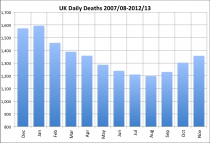
Enlarged
UNITED STATES
Similarly, the USA death rate in January and February is more than 1000 deaths per day greater than in July and August.
Indur M. Goklany wrote in 2009: “Data from the US National Center for Health Statistics for 2001-2008, shows that on average 7,200 Americans died each day during the months of December, January, February and March, compared to the average 6,400 who died daily during the rest of the year. In 2008, there were 108,500 ‘excess’ deaths during the 122 days in the cold months (December to March).”
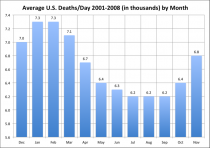
Enlarged National Center for Health Statistics
Despite claims that extreme heat in increasing and cold decreasing, the data says the un-manipulated state extreme temperature data shows the opposite.
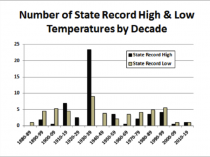
Enlarged
23 of the state all-time record highs occurred in the 1930s and 38 before 1960. There have been more record lows since the 1940s than record highs.
CANADA
Statistics Canada also reports deaths by month. The graph below shows the deaths per day for each month in Canada averaged over the years 2007 - 2011.
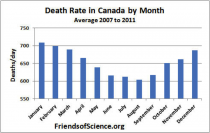
Enlarged
The graph shows that the death rate in January is more than 100 deaths/day greater than in August. See more here.
AUSTRALIA
Even down under in Australia we see the same story. Queensland University of Technology found (Source Science Daily) Australians are more likely to die during unseasonably cold winters than hotter than average summers.
Across the country severe winters that are colder and drier than normal are a far bigger risk to health than sweltering summers that are hotter than average.
QUT Associate Professor Adrian Barnett, a statistician with the Institute of Health and Biomedical Innovation and the lead researcher of the study, said death rates in Australian cities were up to 30 per cent higher in winter than summer.
The researchers analyzed temperature, humidity and mortality data from 1988 to 2009 for Adelaide Brisbane, Melbourne, Perth and Sydney.
Professor Barnett said the finding that hotter or more humid summers had no effect on mortality was “surprising.” “We know that heat waves kill people in the short-term, but our study did not find any link between hotter summers and higher deaths,” he said.
EXCESS WINTER ECONOMIC IMPACT
There’s something that befudles economists and the administration about the U.S. economy in the first three months of every year: It frequently grows at a much slower pace than in the other nine months. The below academic paper, authored by the Federal Reserve Of Chicago, validates the growing link between advancing cold and its impact on economies. From slowing money velocity to low bond yields and reduced consumer spending, behavioral economics are well documented here and offer implicit confirmation that not only is the planet not warming but that cold weather is partially responsible for the slow economic recovery following the 2008 economic crisis. As the Federal Reserve grapples with interest rate policy, the credibility of U.S. dollar may be at stake. Investors worldwide evaluate it’s health with the U.S. treasury market a proxy, roiled recently by a sequence of Federal Reserve revised Gross National Product numbers. We ask this question: were initial strong first quarter GDP numbers during the past several years skewed by faulty reporting of mild winter weather, then later adjusted lower by the impact of under reported cold weather? The implications of such divergences are enormous to world markets.
Alec Phillips, an economist at Goldman Sachs, noticed that from 2010 through 2014, growth in the first three months of the year has averaged 0.6 percent, while it has averaged 2.9 percent in the other three quarters.
And Macroeconomic Advisers, a forecasting firm, has found that the pattern goes back further: Since 1995, outside of recessions, the first quarter has grown at half the pace of the other three.
The government agency charged with calculating the economy’s growth rate said it would adjust its methods in an effort to resolve the problem. While other economists, including at the Federal Reserve in Washington, have concluded that the government’s figures are largely accurate. The first-quarter weakness over the years is in part due to to harsh winter weather. Source
See the new Federal Reserve study on the effect of cold on the economy here. See also here how BofA and some FED divisions had scoffed at cold weather impacts but are seriously lobbying to have government adjust GDP numbers to come better in line with their bad forecasts.
---------
Met Office Issues Warning That Temperatures Could Plummet As Sun Enters Cooler Phase
UK Daily Mail
Britain could be on the verge of a mini Ice Age as the Sun enters a cooler phase, the Met Office warned yesterday. The last big chill was felt hundreds of years ago when Frost Fairs were held on the frozen River Thames.
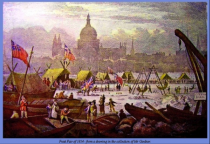
Enlarged
However the Met Office said the new freeze will not be enough to cancel out the effects of global warming.
Met Office’s Hadley Centre, which looks at long term forecasts, said there was a 15-20 per cent chance that we could match the temperatures last seen in 1645-1715 - sometimes called the Little Ice Age - when the River Thames froze over.
This could take place at some point within the next 40 years.
The prediction is based on counting sun spots - dark patches on the sun - that are hot spots and signs of increased solar activity.
The decrease in the sun’s heat is known as a ‘Maunder minimum’ after Walter Maunder - the astronomer who first noted sunspots were at their lowest during the cold period between 1645 and 1715.

Enlarged
Studies by the Met Office and others have found a decrease in sun spots - suggesting the sun may be going through a cooler phase.
The cooling effect is expected to be strongest in northern Europe, the UK and eastern parts of North America - particularly during winter. For example, for northern Europe the cooling is in the range -0.4 to -0.8C.
Jul 04, 2015
Food for all
Scientific Alliance
Although not a household name, Sir Fazle Hasan Abed is credited with helping tens of millions of people in poor countries; for this, he has been awarded the 2015 World Food Prize (Anti-poverty pioneer wins 2015 World Food Prize). The organisation he founded as the Bangladesh Rural Advancement Committee in the early 1970s has become BRAC, the largest development organisation in the world, operating in 11 countries in Asia, Africa and the Caribbean.
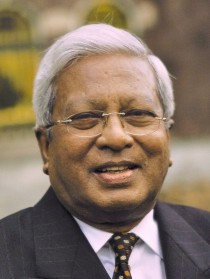
To quote from the organisation’s website, “BRAC...catalyses lasting change, creating an ecosystem in which the poor have the chance to seize control of their own lives. We do this with a holistic development approach geared toward inclusion, using tools like microfinance, education, healthcare, legal services, community empowerment, social enterprises and BRAC University. Our work now touches the lives of an estimated 135 million people...”
The World Food Prize was established in 1987 by Norman Borlaug, whose development of dwarf rice and wheat varieties ushered in the Green Revolution which proved the predictions by Ehrlich and others of a Malthusian catastrophe comprehensively wrong (or simply ahead of their time, depending on your point of view). Borlaug received the Nobel Peace Prize for his work, and instituted the World Food Prize to recognise “outstanding individuals who have made breakthrough achievements contributing to improving the quality, quantity or availability of food throughout the world”.
Food insecurity often does not get the attention it truly deserves, except in the case of devastating local famines. But it underlies our entire civilization. If life is simply a struggle to get enough food to survive, people’s potential contribution to society is almost completely snuffed out. BRAC addresses this in particular by empowering women. As Sir Fazle says “Only by putting the poorest, and women in particular, in charge of their own lives and destinies, will absolute poverty and deprivation be removed from the face of the Earth.”
His organisation’s role is broader than simply ensuring people have sufficient food, but this is the first basic need fulfilled when people lift themselves out of poverty. With enough nutritious food, adults can work productively. Well-nourished mothers give birth to babies of normal weight. Well-fed infants avoid stunting and develop both physically and mentally into healthy, productive adults.

All of this is good, but it also introduces a philosophical dilemma. As people no longer struggle to survive day to day, they want more out of life and they want a better life for their children. It isn’t possible just to turn struggling subsistence farmers into well-fed subsistence farmers. Some will develop businesses, small farms will coalesce into larger, more productive ones and many people will leave the land for a new life in the city.
Society will change, and today’s poor people will want the same things that today’s rich countries enjoy. Not that the path of development will necessarily be identical. For example, it is becoming obvious that many developing countries are by-passing fixed-line telephone networks almost entirely and adopting mobile phones for internet access as well as calls. Similarly, a distributed electricity supply to rural areas may be difficult to deliver in the short term, so there is a real role for small-scale solar power, at least in the interim.
But all this relies on people being able to feed themselves properly. A recent Economist analysis (Is the world running out of food?) shows that sufficient food is being produced to feed today’s population, but points out the problems associated with increasing harvests by perhaps a further two-thirds to feed nine billion increasingly prosperous people by mid-century.
It is widely recognised that this is not just about farmers producing enough food. Crops also have to be delivered to consumers in good condition. In the rich world, there is a large amount of food wasted in the home - one of the downsides of prosperity - but poor roads, lack of refrigeration and attacks by pests mean that a significant amount of food harvested in developing countries never reaches the consumer at all.
Growing enough food and avoiding waste are both important, but so is affordability. Poor people who do not grow enough of their own food often don’t have any money to buy more. This is where helping people lift themselves out of poverty is so important. Once that first step on the development ladder has been taken, there is a natural build-up in momentum which transforms societies. It has already happened in the south-east Asian ‘tiger economies’. We are witnessing it in China today, and tomorrow even the poorest countries in Africa will hopefully be set on the same path.
These changing societies will have an impact on their environment; whether this is negative, positive or neutral is in the eye of the beholder. What we do know, however, is that more prosperous societies value the natural environment more and are more willing to spend to improve water and air quality and conserve species.
One of the consequences of these trends is what has become known as ‘sustainable intensification’ of farming. The aim is to produce more food from the same area of land, so avoiding further encroachment on natural habitats. The modern ‘industrialised’ and globalised food chain is anathema for supporters of the rich world fashion for organics and localism, but the reality is that this is the only way to global population will be properly fed.
Another consequence is the increasing importance of large multinational businesses in supplying seed and other farming inputs. The present handful of companies is likely to become even more concentrated, with Monsanto trying hard to take over Syngenta and, failing that, having the agricultural division of Bayer in its sights. But their dominance of the start of the food chain is only made possible because they provide better seeds and crop protection methods than smaller competitors. Farmers make a free choice.
In fact, the supposed dominance by the big six agricultural supply companies is the subject of an interesting perspective in a Forbes article: Who controls the food supply?, in which the author makes a case for the influence of the anti-GMO activist lobby being at least as strong. Whatever the rights and wrongs of this, the system delivers at the moment and innovation and free markets look set to continue to deliver for the foreseeable future. In the meantime, congratulations to BRAC for making a difference to the lives of so many people.
|







_thumb.png)






_thumb.jpg)








